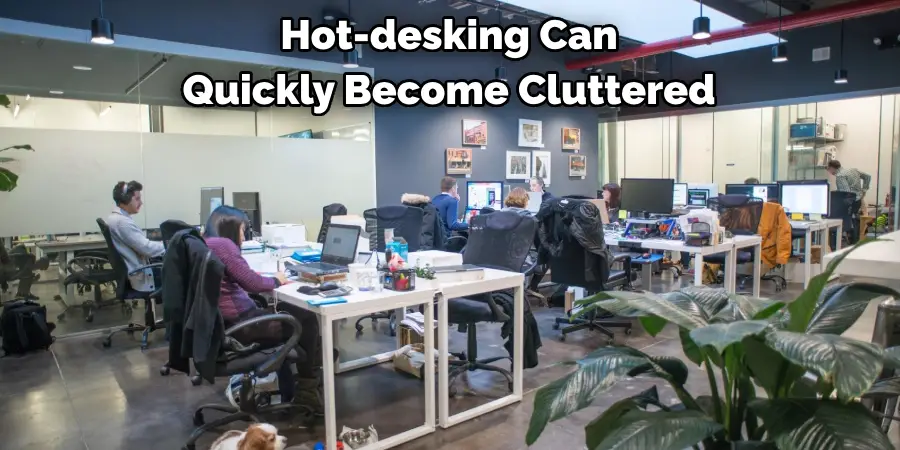Do you work in an open office concept? Hot-desking is becoming increasingly common, especially as companies look for ways to make the most of their limited space. With hot desking comes added responsibility for both employers and employees to ensure a successful, comfortable workspace experience.
In this blog post, we’ll take an in-depth look at how to manage hot desking effectively by discussing the advantages and disadvantages of this flexible working arrangement along with key tips on how best to prepare your workspace for success. If you’re looking to get more out of your deskspace while still fostering a productive environment – read on!

7 Best Ways on How to Manage Hot Desking
1. Set Guidelines and Expectations:
Before your team starts hot-desking, make sure to set expectations of use. This can include how often desks should be cleaned when new desk assignments will take place each week or month, and who is responsible for organizing the workspace. Setting clear guidelines in advance will help everyone stay organized and productive.
2. Designate Desks:
Assign desks to each person or assign them on a rotating basis. This way, teams can still meet up without having to worry about sitting in the same spot every day. Also, consider setting up “zones” with desk assignments for different team members so they still have their own special space to work in.

3. Encourage Communication:
Hot-desking works best when everyone is communicating effectively. Make sure that your team knows the importance of talking to each other and staying connected, regardless of where they’re sitting. Have regular meetings and check-ins so that all members can stay up-to-date and be aware of any changes in the hot-desking system.
4. Encourage Flexibility:
To make hot-desking work, you’ll need to encourage your team to be flexible. Make sure that everyone understands that they may have to move or switch desks from time to time and that this is part of the way the workspace works. This way, everyone can adjust to the new system without too much disruption.
5. Promote Cleanliness:
Hot-desking can quickly become cluttered and messy if not managed properly. Encourage your team to keep their workspaces clean and tidy at all times so that they don’t detract from the overall hot-desking environment. If you have storage options available, provide them to make it easier for team members to keep their desks free of clutter.

6. Provide Comforts:
When managing a hot-desking office, don’t forget about the comforts that each team member needs in order to be productive and comfortable. Invest in ergonomic chairs, adjustable monitor stands, and other items to help your team members stay comfortable and productive. For extra comfort, provide blankets and cushions for longer hours.
7. Leverage Technology:
Technology can help make hot-desking more efficient and effective. Invest in scheduling software or apps that allow team members to check who is sitting at what desk each day or find out when certain desks are available so they don’t have to wander around the office looking for a spot. Automating the process can make hot-desking much more efficient and organized.
Hot-desking can be a great way to maximize space and promote collaboration, but with any new working arrangement comes challenges. By following these tips, you’ll be able to manage hot desking effectively and create an environment where everyone is productive and comfortable.
Additional Tips and Tricks to Manage Hot Desking
1. Be sure everyone has access to the same amenities. Whether it’s a coffee maker or printer, make sure that all employees have equal access to essential equipment.
2. Keep desks and workspaces organized. Encourage employees to keep their workspace clean and tidy throughout the day, so they are not inconvenienced when another employee takes over the desk in the evening.
3. Make sure each employee has a storage space of their own. Allowing employees to have lockers or drawers that they can use for personal items such as laptops, papers, and lunchboxes will ensure that they feel comfortable even when working at a shared desk.
4. Designate areas where hot desking is allowed. It’s best to designate spaces that are separate from employees’ assigned workstations, so they know where to go when hot desking and don’t get in the way of a single-desk employee.
5. Communicate hot desking rules with everyone. Make sure all employees understand the rules of hot desking and abide by them. This will help to ensure that everyone is comfortable with the system.

6. Provide a desk cleaning kit for each employee. It’s important to maintain cleanliness and hygiene in the workplace, so provide employees with a desk cleaning kit that includes wipes, paper towels, and other items they can use to keep their workspace hygienic.
7. Create an easy-to-follow hot desking schedule. An effective way to keep track of who’s using which desk is by setting up an easily accessible hot desking schedule that all employees can view and reference.
8. Establish an etiquette policy for hot desking. Create a policy that outlines how employees should behave when using a shared desk, such as not leaving personal items, cleaning up after themselves, and refraining from loud conversations.
Overall, hot desking can be a great way to maximize desk space in the workplace while still allowing employees to have their own workspace. However, it’s important to make sure that everyone is on board with the rules of hot desking before implementing them in your office. By following these tips and tricks, your employees will feel comfortable when hot desking and be more productive in the long run.
Advantages of Hot Desking
1. Hot-desking can significantly reduce overhead costs such as rent, furniture, and equipment. It also reduces the need for physical space and allows businesses to have a more flexible workspace.
2. It encourages collaboration and improves communication among employees since they are able to move around and interact with different colleagues on a regular basis. This can lead to increased productivity and creativity in the workplace.
3. Hot-desking increases employee satisfaction by providing more options for how they work. Employees can choose which workspace suits their needs best, allowing them to be more productive and comfortable.
4. Hot-desking is beneficial for both employers and employees because it gives employees more control over their environment, while also helping the company save money by reducing overhead costs. It also allows businesses to be more flexible in terms of how they use their physical space.
5. Finally, hot-desking can help reduce environmental impact by reducing the need for physical office space and cutting down on paper waste. This is beneficial not only to the environment but also to businesses, as they can save money on utilities and other expenses related to traditional offices.
Disadvantages of Hot Desking
1. One of the main disadvantages of hot-desking is that it can be difficult to keep track of who is using which workspace. This can lead to confusion as employees may not know where their colleagues are working from, or they may end up sharing a desk with someone else without realizing it.
2. In addition, hot-desking can also have a negative impact on workflow and team dynamics. Since employees are constantly changing their workspace, it can be difficult for teams to maintain continuity and focus on tasks or projects.

3. Another problem with hot-desking is that it may not be suitable for all types of businesses. If a company has sensitive information that needs to remain secure, then a traditional office setup would be the better option.
4. Finally, hot-desking can also lead to feelings of isolation among employees who are constantly changing their workspace and may not have access to the same resources or support as their colleagues in a traditional office environment.
Overall, hot-desking can be beneficial for businesses that want to reduce overhead costs and give employees more control over their workspace. However, it is important to consider the potential drawbacks before implementing a hot-desking policy in order to ensure that it is the right solution for your business.
Frequently Asked Questions
What is Hot-desking?
Hot-desking is a system where multiple employees use the same desk or workspace at different times, either in an office or another location. It allows for a more flexible and cost-saving workplace environment by reducing the need for physical space and equipment.
What Should I Consider Before Implementing a Hot-desking Policy?
Before implementing a hot-desking policy, you should take into account the potential advantages and disadvantages, as well as the security and privacy needs of your business. You should also consider the impact it may have on team dynamics and workflow, as well as employee satisfaction and morale.
Are There Any Alternatives to Hot-desking?
Yes, there are a few alternatives that have similar benefits but may be more suitable for certain businesses. For example, instead of hot-desking, companies can opt for flexible working hours and remote working options for their employees. They can also provide standing desks or ergonomic furniture to promote better posture and comfort. Additionally, businesses may opt for activity-based working, which gives employees the freedom to choose their workspace based on what task they are working on at any given time.
Conclusion
Hot desking can be a great way for businesses to save on space and money while providing employees the opportunity to remain flexible and collaborative. It’s important to establish clear policies on how the space is used, including seating restrictions, guidelines on cleanliness and tidiness, and assigning common areas to be used. By keeping all these tips in mind, you should be able to enjoy the benefits of hot desking without any negative consequences.
Now that you’ve learned how to manage hot desking successfully, it’s time to implement the policy for your business. With proper planning and communication, you can ensure that everyone is on board and ready to make the most of this workspace solution. Good luck!

